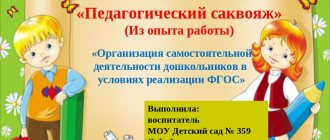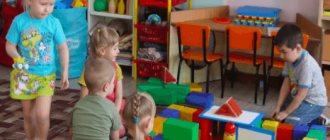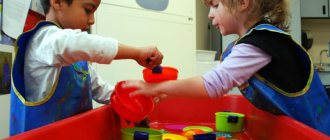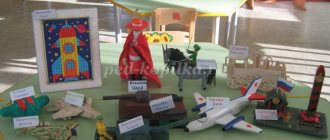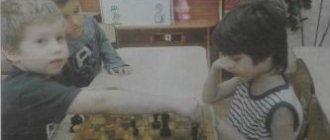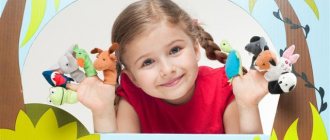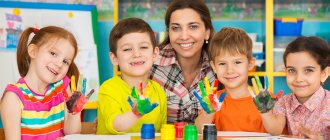Organization and conduct of walks in the senior group of kindergarten
Experience as a preschool teacher.
Methodology for organizing and conducting walks in the senior group Relevance of the topic: Currently, the task of preserving and strengthening the health of children, both physical and mental, introducing them to a healthy lifestyle and mastering modern health-saving technologies is one of the most significant and priority ones. Most modern children rarely communicate with nature. do not come into contact with it, this deprives them of the opportunity to know and feel it not only with their eyes, but also with other senses. By communicating with nature, children could not only get psychological relief, but also get a positive emotional mood and improve their health. Nature is a rich storehouse, invaluable for the intellectual and speech development of a child. The goal is to improve health, prevent fatigue, physical and mental development of children, and restore the functional resources of the body that have been reduced during activity. Objectives: • to provide a hardening effect on the body in natural conditions; • help improve the level of physical fitness of preschool children; • optimize the motor activity of children and promote the cognitive, speech, artistic, aesthetic, social and personal development of children. Children's stay in the fresh air is of great importance for the physical development of a preschooler. Walking is the first and most accessible means of hardening a child’s body. It helps to increase its endurance and resistance to adverse environmental influences, especially colds. During the walk, children play and move a lot. Movement increases metabolism, blood circulation, gas exchange, and improves appetite. Children learn to overcome various obstacles, become more agile, dexterous, courageous, and resilient. They develop motor skills and abilities, strengthen the muscular system, and increase vitality. A walk promotes mental development, as children gain a lot of new impressions and knowledge about the world around them. Types of walks (at the venue): · on the site of the Institution; - walking walks outside the Institution site (senior preschool age at a distance of up to two kilometers); - in the functional premises of the kindergarten (on activated days). Types of walks by content: · Traditional, which includes children’s work activities (cleaning up leaves, snow, etc.), active and quiet games, etc.;; · Thematic: consisting of observations and conversations on a specific topic (animals, clouds, trees, city transport, etc.), can be a street theater performance, a quest with overcoming simple obstacles - requires a pre-prepared script; · Targeted (conducted from the second junior group with access beyond the kindergarten); · Excursion (conducted systematically from the middle group at least once a month); · Hiking, hiking (carried out with children of senior preschool age 1-2 times a year). The duration of walks on the street The daily routine of the kindergarten provides for a daily daytime walk after classes and an evening walk after afternoon tea. The time allotted for walking must be strictly observed. Its total duration is 4 - 4.5 hours. To achieve a healing effect in the summer, the daily routine provides for children to spend maximum time in the fresh air with breaks for meals and sleep. During the winter period, outdoor walks are carried out 2 times a day: in the first half of the day - before lunch, in the second half of the day - before the children go home. In order to prevent hypothermia of body parts (face, arms, legs) in cold weather, it is recommended to send children to a heated vestibule for heating for no more than 5-7 minutes. Winter walks in kindergarten for children under 4 years old are held at temperatures down to -15°C, for children 5-7 years old at temperatures down to -20°C. -The time for each age group to go for a walk is determined by the mode of education and training. Walking is prohibited due to wind force exceeding 15 m/s. Walk structure: 1. Observation. 2. Outdoor games: 2-3 games of high mobility, 2-3 games of low and medium mobility, games of children’s choice, didactic games. 3. Individual work with children on the development of movements and physical qualities. 4. Children's labor on the site. 5. Independent play activity. The sequence of structural components of a walk may vary depending on the type of previous activity. If the children were in an activity that required increased cognitive activity and mental stress, then at the beginning of the walk it is advisable to conduct outdoor games, jogging, and then observations. If there was a physical education or music lesson before the walk, the walk begins with observation or quiet play. Each of the required components of the walk lasts from 7 to 15 minutes and is carried out against the background of independent activity. Observation A large place on walks is given to observations (pre-planned) of natural phenomena and social life. Observations can be carried out with a whole group of children, with subgroups, as well as with individual children. At a younger age, observations should take no more than 7-10 minutes and be bright and interesting; at an older age, observations should last from 15 to 25 minutes. They should be carried out daily, but each time children should be offered different objects to consider. Objects of observation can be: • Wildlife: plants and animals; • Inanimate nature: seasonal changes and various natural phenomena (rain, snow, flowing streams); • Adult labor. Observations of the work of adults (janitor, driver, builder, etc.) are organized 1-2 times a quarter. Types of observation: • Short-term observations are organized to formulate information about the properties and qualities of an object or phenomenon (children learn to distinguish shape, color, size, spatial arrangement of parts and the nature of the surface, and when familiarizing themselves with animals - characteristic movements, sounds made, etc. • Long-term observations are organized to accumulate knowledge about the growth and development of plants and animals, about seasonal changes in nature. At the same time, children compare the observed state of the object with what it was before. Motor activity The leading place during the walk is given to games, mainly outdoor ones. They develop the basic movement, relieves mental stress from activities, and develops moral qualities. The choice of game depends on the time of year, weather, air temperature. On cold days, it is advisable to start a walk with games of greater mobility associated with running, throwing, jumping. Fun and exciting games help children better tolerate cold weather.In damp, rainy weather (especially in spring and autumn), sedentary games that do not require a lot of space should be organized. Games with jumping, running, throwing, and balance exercises should also be carried out on warm spring, summer days and early autumn. During walks, folk games with objects such as ring throw, skittles can be widely used, and in older groups - elements of sports games: volleyball, basketball, badminton, table tennis, football, hockey. In hot weather, water games are held. Time for outdoor games and physical exercises during a morning walk: in junior groups - 6 - 10 minutes, in middle groups - 10-15 minutes, in senior and preparatory groups - 20-25 minutes. On an evening walk: in junior and middle groups - 10-15 minutes, in senior and preparatory groups - 12-15 minutes. Every month, learning 2-3 exercises (repetition for a month and consolidation 3-4 times a year) At a younger age, games with text (imitation of the actions of the teacher) are recommended. In the middle group, the teacher distributes roles among the children (the role of the driver is performed by a child who can cope with this task). In the senior and preparatory groups, relay races, sports games, and games with elements of competition are held. Outdoor games end with walking or low-mobility play, which gradually reduces physical activity. Children are not allowed to walk for long periods of time without moving. Children with reduced mobility and low initiative require special attention and should be involved in outdoor games. Labor activity of children on the site Labor activity during a walk is of great educational importance. You can see the forms of organizing children's work on the screen. Individual work assignments are used in all age groups of the kindergarten. Collective work makes it possible to develop work skills and abilities simultaneously in all children in the group. During collective work, the ability to accept a common goal of work, coordinate one’s actions, and plan work together is formed. In the younger group, children receive individual assignments consisting of one or two labor operations, for example, taking bird food and putting it in a feeder. The teacher takes turns involving all the children in feeding the birds. Or, for example, collecting pebbles for crafts. Work is organized as “work nearby”, while children do not experience any dependence on each other. In the middle group, two subgroups can work simultaneously and carry out different work assignments; The teacher's constant attention to the quality of work is required; showing and explaining the entire task are sequential steps. In older children, it is necessary to develop the ability to accept a work task, present the result of its implementation, determine the sequence of operations, select the necessary tools, and independently engage in work activities (with a little help from the teacher). Individual assignments become lengthy, for example, collecting and decorating a herbarium. Organization of individual work: - in accordance with calendar planning, the teacher carries out individual work on the cognitive - speech, social - communicative, physical or artistic - aesthetic development of children; — for this purpose, all materials and equipment necessary for the walk are prepared. Individual work during the walk is carefully planned. It is aimed at consolidating any skills, learning a physical exercise with one or more lagging children, practicing sound pronunciation, memorizing poetry, consolidating material in all sections of the program, and developing moral qualities. It is important that the child with whom individual work is carried out understands its necessity and willingly completes the proposed tasks. Children's independent activities during walks also require competent guidance. During independent play activities, children reflect the impressions received in the process of educational activities, excursions, everyday life, and acquire knowledge about the work of adults. This happens in the process of role-playing games. One type of creative games is construction games with natural materials: sand, clay, small pebbles, etc. To organize independent activities, it is necessary to create conditions: attributes, external materials, tools for work. It is necessary to comply with sanitary and hygienic requirements for the storage and placement of removed material. “The world surrounding a child is, first of all, the world of nature with an endless wealth of phenomena, with inexhaustible beauty.” V.A. Sukhomlinsky Used literature: 1. Voronkevich O. A. Welcome to ecology 2. Komarova T. S. Classes in visual arts. 3. Kondratyeva N. N. Children's environmental education program “We” 4. Makarova L. P. Theatrical holidays for children 5. Nikolaeva S. N. Young ecologist 2004 6. Pavlova L. Yu. Collection of didactic games 7. Skorolupova O. A. Classes with children on the topic “Autumn” 8. Stepanenkova E. Ya. Collection of outdoor games for children 2-7 years old 9. Shchetkin A. V. Theatrical activities in kindergarten
We recommend watching:
Synopsis of a comprehensive educational program for the development of fine motor skills and coordination of finger movements in the senior group Synopsis of a lesson on the surrounding world in the senior group with a presentation Synopsis of the organization of household work "Book Workshop" in the senior group Synopsis of direct educational activities on the development of speech and the surrounding world ( older
Similar articles:
Nurturing cognitive interests in children of senior preschool age
Identification of cognitive interests in preschool children
Formation of cognitive interest in mathematics among older preschoolers
Cultivating cognitive interest in nature in children of senior preschool age
Cultivating cognitive interest in book graphics in children of senior preschool age
